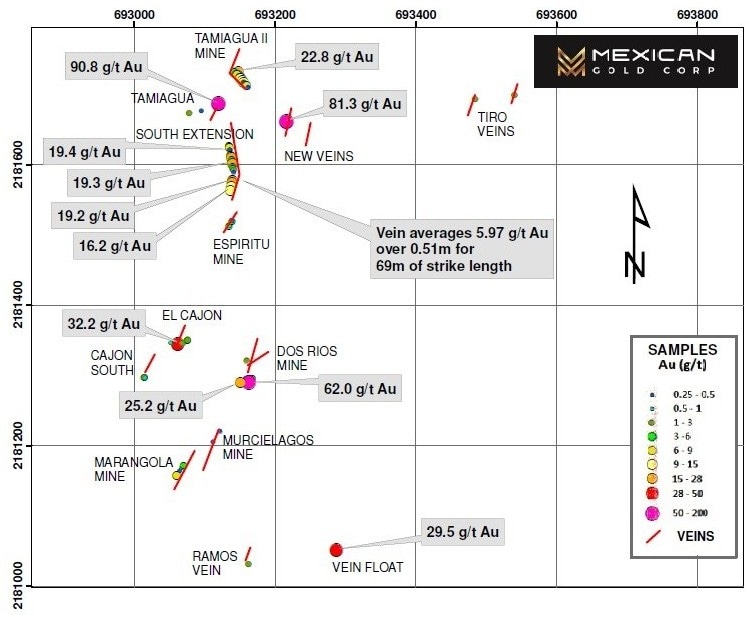Oct 1 2019
Mexican Gold Corp. reported that it will commence a vigorous exploration and drilling program for the rest of 2019 to search for highly prospective targets at its Las Minas Project.
 Pueblo Nuevo Target. (Image credit: Mexican Gold Corp.)
Pueblo Nuevo Target. (Image credit: Mexican Gold Corp.)
Highlights:
- A planned 3000 m drill program designed to test two geological concepts and four prospective targets
- Drilling is set to begin in mid-October
- The four targets being drilled are the Cinco Senores TEM Anomaly, Pueblo Nuevo, El Dorado, and Las Minillas
- The two geological concepts being drilled are the potential for skarn mineralization, Sub-Sill and at the Mancuerna Dike Swarm
Drilling Overview
Surface work at Pueblo Nuevo in 2018 revealed numerous gold-bearing quartz veins with very high values. Mineralized veining extends across hundreds of meters of strike and vertical extent. The Pueblo Nuevo target has become a priority for diamond drilling in 2019 due to its high grades.
The preliminary targets will comprise cross structures close to the historic Dos Rios mine and numerous parallel veins near the Tamiagua mines. Drilling has also been scheduled in the area of the old Miqueta mine situated 400 m to the west of the valley which will offer 600 m of cross-section analysis.
Cinco Senores lies on the same promising sill contact hosting the El Dorado skarn deposit. High-grade surface samples, widespread historic mining, and numerous promising drill intersections make this an exciting target. Most of the valley around Cinco Senores is overburden-covered and remains uncharted and untested for mineralization.
A reinterpretation of the 2017 TEM survey positions a robust conductive anomaly over the northern part of Cinco Senores which seems to extend 500 m north toward Las Minillas. This anomaly may signify a buildup of mineralization on the lower or the upper contact of the El Dorado sill.
Las Minillas has one of the largest historic mines in the region. So far, the Las Minillas target has only witnessed two short drill holes because the underlying geology was not properly understood before. Reprocessing of a complete magnetic survey on orthogonal lines from 2017 delineates the interactions of the El Dorado sill and a NNW trending dike, similar to the rich El Dorado dike contact. A number of holes are scheduled to test the dike contacts in 2019.
Wide hole-spacing in some pockets of the identified resource at El Dorado offers an opportunity to incorporate ounces to the resource by way of extra drilling to link the statistical correlation. Mexican Gold Corp. has detected three pockets that will see one drill hole each so as to potentially add mineralization at El Dorado.
Geological Concepts
Skarn deposits are identified on the upper contact of the El Dorado sill. Associated deposits are frequently known to host noteworthy skarn mineralization on the lower contacts as well. New proof indicates that the El Dorado sill has a thickness of about 200 m which makes the use of geophysical data and drilling possible.
Drilling is scheduled for 2019 to test the lower sill contact in areas where there are geophysical or geological features of interest. These comprise deep-seated TEM conductors and a 3 km-long zone of pyrite + argillic alteration with sporadic gold content in the sill which lies along a key regional fault.
A huge volume of intrusive rock, basically matching the El Dorado sill, lies beneath a 3.5 km x 1 km portion in the south-east part of Mexican Gold’s large concession hosting all of its existing mineralization. This area had been interpreted in various ways as part of a stock or as a dike swarm.
Comprehensive mapping in 2018 recognized skarn between E-W trending dikes, ratifying the latter interpretation. The Santa Cruz Au-Cu resource has already been credited to E-W dikes at the edge of this intrusive system. As Santa Cruz is said to have totaled more than 10 million tons pre-erosion, the search for additional deposits of this type is justified and some preliminary exploratory drilling is scheduled for 2019.